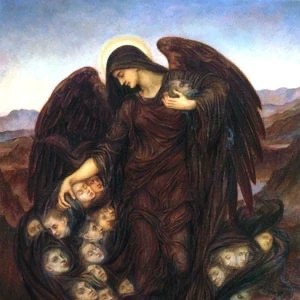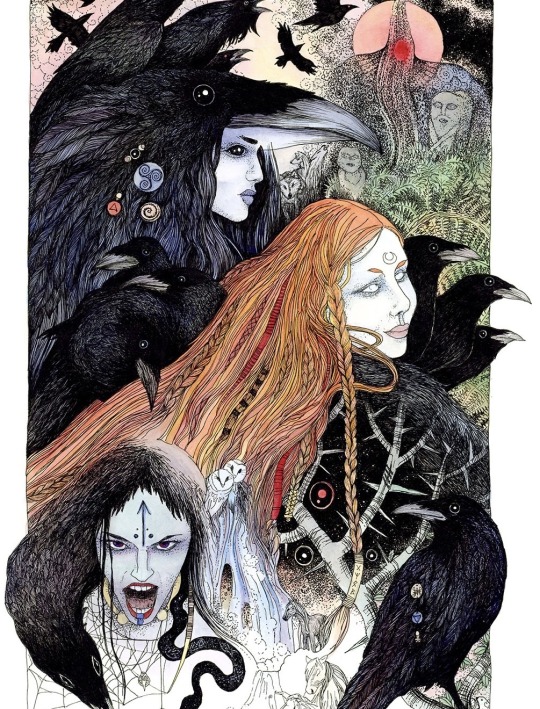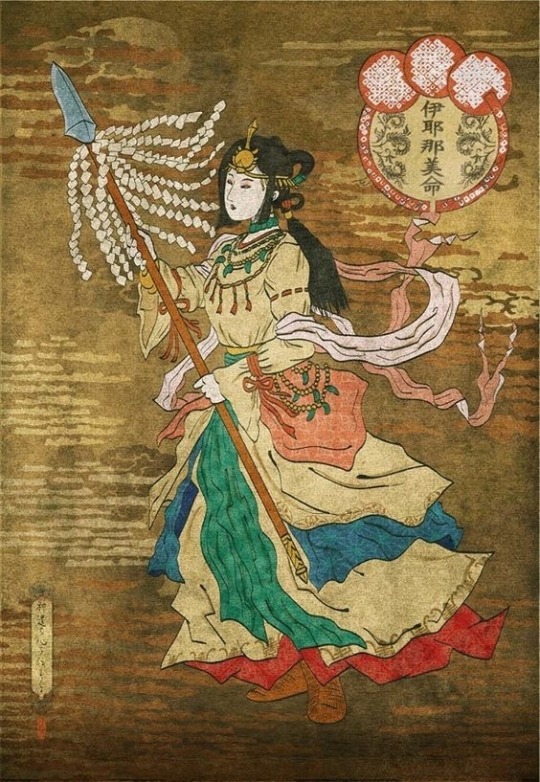Text
I'm reading Greek and Roman Necromancy by Daniel Ogden and once again encountered the trope of oracular locations and temples keeping snakes for various ritual purposes and "feeding them" on a kind of honey cake, which as far as I know would not be interesting whatsoever to a snake and even if a snake ate a baked good it would probably have trouble digesting it (I assume). so I was mulling this over, and naturally Ogden doesn't address it, I've actually never read any writer on these subjects address the animal husbandry involved with ancient rituals, which is always frustrating , and it occurred to me that snakes wouldn't eat a Twinkie but rodents and insects absolutely would.
if your ritual snakes are just being kept in some sort of enclosure, especially something like a pit or a katabasis (the Greeks were really big on a Amigara Fault-type procedure where people would go into holes in the earth in various ways and then come out of the holes in various ways and during this process be understood to have visited the underworld or received a vision from an oracular ghost such as Trophonius, the mechanical details of the process aren't clear), you probably aren't directly observing them very often except for any part of the rituals that involve handling, during which the snakes wouldn't be eating anyway. but alone in their enclosures with a bunch of bakery snacks, the rodents and bugs could sneak out of hiding and get grabbed by the snakes.
also I imagine a lot of the smoke and mirrors of the staff at these temples involved managing the various sacred animals somewhat like a petting zoo or a feeder goldfish tank at PetSmart, and just disappearing any of them that died so the clients wouldn't see them. it's likely the staff were cleaning, feeding, and taking care of the snakes at various locations and the dogs at the Asclepias temple and so on.
one has to imagine that most temple priesthood were probably just people who had gotten that particular job somehow, and not the ecstatic true believers that are depicted in every classicist romantic painting and most mythological or fictional imaginings of such places. of course there are tons of modern fiction books that imagine the same thing I do, I read The Jaguar Princess by Clare Bell when I was about 13 and loved the plain and practical descriptions of Aztec temple life, the process of creating art, and the anatomical approach to the idea of a were-jaguar (i have no idea if this book stands up, probably not), I think it permanently contextualized my thinking about ancient ritual as practical and pedestrian for the people who worked in that field. it's fun to imagine the blood-soaked ancient temples in any part of the history of humanity being as ho-hum as an Anglican church service, but they probably were for most people.
345 notes
·
View notes
Text
tired of cannibalism as a metaphor for love or sex. can we get into cannibalism as a metaphor for colonization.
35K notes
·
View notes
Text
💀Goddesses of death💀

Ereshkigal: Mesopotamian goddess of death, the dead, and the underworld.
Ereshkigal is the queen of the underworld, the keeper of balance, the punisher of evil & maintains order against chaos. She may have also been associated with the earth & the waters of life in Mesopotamian legend. She was associated with the city of Kutha and featured in the myth of Inanna's Descent to the Underworld. She was also connected to other deities such as Nergal, Ninazu, and Ningishzida. Ereshkigal was said to be the sister of Inanna.

Oya: African Goddess/orisha of death, storms, winds & thunder.
Oya is a powerful goddess/orisha in Nigeria who controls storms and death and is married to the thunder god, Shango. She is a shape-shifter who often appears as a mortal woman or animal while overseeing justice and bringing sudden change. She is also a guardian of women and the dead, able to call forth death or delay it. Oya is associated with rebirth and magic, and her favorite colors are maroon and copper.

The Keres: Greek goddesses of Death, bloodshed & violence.
The Keres were female death spirits and goddesses who personified violent death. They were drawn to bloody, intense deaths on battlefields and were daughters of Nyx, Goddess of Night. They did not have the power to kill but would wait and then feast on the dead. They were described as dark beings with gnashing teeth & claws, with a thirst for human blood. They would hover over the battlefield and search for dying/ wounded men.

The Morrigan: Irish Goddess of death, fate, war & sovereignty.
The Morrígan, also called the Phantom Queen, is a bewitching goddess associated with war and fate, often appearing as a crow, encouraging bravery and strength in battle, & foretells doom or victory. The Morrígan is often described as a trio of sisters, representing the goddess's role as a guardian and warrior. She can appear in many forms like an old woman, a crow, a beautiful sorceress, or a fearsome creature.

Mictecacihuatl: Aztec Goddess of death & the underworld.
Also known as the Lady of the Dead, Alongside Mictlantecuhtli, her consort, she rules over Mictlán, the lowest Aztec underworld realm. She guides the departed souls on their transformative journey from life to the afterlife and embodies the profound duality of existence. The Dia de los Muertos is a vibrant festival that allows families to honor deceased loved ones with ofrendas and calavera imagery, inspired by Mictecacihuatl, who is now called Santa La muerte.

Kali-ma: Hindu Goddess of destruction, death, change & time.
Kali-ma is the wrathful & protective force of Shakti (energy), She's a caring mother to her devotees/innocent people and the destroyer of evil, she expresses the dual nature of the destruction that must come before new beginnings. Kali ma embodies the power of all, transcending good & evil to protect her people against negativity. Kali ma is Mother Nature, primordial, nurturing, and devouring, She is vested in freeing beings, granting salvation.

Hel: Norse Goddess of death, the underworld & decay.
Hel, the half living and half dead goddess, is one of Loki's children, and rules over the realm of the dead, she mostly receives those who died of illness or old age in her realm. Hel is often depicted as a fearsome figure, and in Her realm, Helheim, is considered one of the nine worlds in Norse cosmology and is located in the lowest part of the universe. In the events of Ragnarok, Hel plays a crucial role. It is foretold that she will lead an army of the dead to fight against the gods.

Morana: Slavic Goddess of death, winter, magic & dreams.
Morana is a Slavic goddess associated with seasonal agrarian rites based on the idea of death and rebirth of nature. the death of Morana at the end of winter becomes the rebirth of Spring of the Goddess Vesna, representing the coming of Spring, joy & life. She is still worshipped to this day and is often described as a vengeful, powerful goddess. She is married to the spring/love God Yarilo but their relationship is not seen as healthy.

Izanami: Japanese Goddess of Death, darkness & creation.
Izanami is a Shintō creation mother goddess who became the Japanese goddess of death after she died while giving birth. Her name, Izanami, means ''the female who invites.''. She can create many lands and other divine beings, has the power of death and could command gods/spirits of the underworld. Izanami & Izanagi are the creators of the Japanese archipelago and the creators of the powerful deities Amaterasu, Tsukuyomi, and Susanoo.
85 notes
·
View notes
Text
By accepting as inevitable humanity’s demise by its own hand, post-apocalyptic fiction places no responsibility on the living to course correct.
Solarpunk looks towards a post-capitalist future of renewable energy. It rejects climate “doomerism” and shows what our collective future could look like if we heal our relationship with the natural world.
Far from Star Trek’s “full luxury space communism,” where humans race across galaxies via endless sources of energy, the technology in solarpunk is imminently achievable. In the anthology Future Primitive: The New Ecotopias, science fiction writer and democratic socialist Kim Stanley Robinson describes this genre as rejecting “the inevitability of the machine future.”
Instead [solarpunk] asks, “What is the healthiest way to live? What is the most beautiful?”
Rather than Elon Musk’s tent cities on Mars, these fictional worlds “cobble together aspects of the postmodern and the paleolithic, asserting that we might for very good reasons choose to live in ways that resemble in part the ways of our ancestors.”
735 notes
·
View notes
Text
Beautiful worlds. Strange phenomena. Terrifying creatures.

You attend a ball of magical nobles and intriguing strangers.
You take a magical lantern offered by hand in the darkness.
You discover the massive ramifications of being wed to a planet.
You sail to an isolated abbey in an ocean of ash.
You have been transformed into a portal, providing passage to travelers.
Tour bizarre and fascinating settings, some which welcome you, some which startle you, some that will never let you go.
Wordsyettocome
WARNING: This blog contains horror, body horror, existential themes, eldritch concepts, unreality, and generally weird and unsettling writing.
Image is downloaded from Pixabay.com.
9 notes
·
View notes
Text
There's something particularly frustrating about how academic fandom studies tend to talk about fandom spaces as being a place for inclusiveness and queer representation when there's still a very prominent misogyny problem throughout them. Even when these studies address issues of racism within fandom shipping dynamics, they still tend to perpetuate the idea that fandom is the rare place where queer ships tend to be more popular than straight ones, without really addressing the fact that this tends to only true when it comes to cis, white, m/m ships. If you want some kind of numerical evidence of this, you just need to look at the statistics on ao3 to see that f/f ships are the least popular kind of pairing on that site. And when you think of the stereotypical big name fandoms, most of them are well known for their m/m ships, with the f/f ships often being dismissed or treated as a joke.
I'm not of the opinion, nor trying to make an argument in support of the idea, that this is due to the stereotype of fangirls fetishising queer men. Instead, I think it's largely due to misogyny* - shocker, I know. I really do think that the stereotypical fangirl gravitates towards slash pairings due to both internalised misogyny and the general prominence of male oriented media over female oriented media (which will therefore have more male characters that are fleshed out with more engaging writing as opposed to their female supporting cast).
However, it's one thing for the abundance of male driven stories to generate more fan works exploring said characters, and another entirely for those same fans to then ignore when we do have media that gives us well written and enjoyable female characters. I think it's in part due to our internalised misogyny that fangirls have a tendency to gravitate towards their familiar male orientated shows and then fixate on the same familiar character types, rather than exploring and celebrating the breadth of female-centric media we have finally been getting produced in recent years. And this inability to allow ourselves to enjoy female characters the same way we do with male ones is what leads to an abundance of slash pairings being celebrated in fandom spaces, while femslash ones struggle to get recognition**. The fact that there's a common joke in fandom spaces about popular pairings developing between two characters who never interacted (or for only a brief scene) is all very well and good fun, but this is almost always referring to a m/m pairing.
As fans we should really reflect on why we might celebrate a male character for doing morally grey things, but then hate a female character for exhibiting those exact same traits. It's fine to genuinely not enjoy the writing of a female character (especially when sexist writing is often to blame), but we should consider how much more willing we seem to be to forgive poor writing when it comes to male characters than we are with female characters. If we can make a million headcanons and claim to love a poorly written male character, who is now viewed as something so far removed from the canon of the media he appears in its practically a different character entirely, why do so many of us seem unwilling to do the same for female characters?
We should be doing the same with our female characters - we should be putting more female characters into our favourite dynamics and tropes. I want to see more enemies to lovers headcanons with femslash pairings; I want nbc hannibal levels of art and meta posts about toxic femslash couples; I want johnlock levels of delusion posts about a femslash couple the story writers are claiming they didn't write the subtext for. I would just really love to log into tumblr and see a femslash pairings tag is trending more than once in a blue moon.
*note: obviously misogny is not the only contributing factor, and this initial argument I'm raising doesn't address the issues surrounding racial, gender-queer identities, and other inequalities within fandom. Please do not think I'm ignoring or downplaying them.
**Theres also an argument to be made here about fangirls projecting themselves onto male characters in order to explore queer relationships, without having to challenge their own internalised misogyny/homophobia, but I'll come back to that later (and this in general) and expand on it some other time I think.
28 notes
·
View notes
Text

I highly recommend this read for anyone struggling with problematic media or problematic creators who uses understanding and information to process and manage difficult feelings.
This book is incredibly timely at the moment and speaks directly to the experiences and challenges that many fans of works that are problematic, turned out to be problematic, or were viewed as problematic (but maybe were actually more complex).
I have not yet finished this book, but it's been excellent so far, and gives some important historical context to the struggles that people have gone through in earlier decades while also acknowledging unique circumstances today due to social media and current cultures of fandom. Read a short review from NPR here.
Knowledge is power.
25 notes
·
View notes
Text
Searching best practices on JSTOR
Hi Tumblr researchers,
As promised, we're going to dive into some best practices for searching on JSTOR. This'll be a long one!
The first thing to note is that JSTOR is not Google, so searches should not be conducted in the same way.
More on that in this video:
youtube
Basic Search on JSTOR
To search for exact phrases, enclose the words within quotation marks, like "to be or not to be".
To construct a more effective search, utilize Boolean operators, such as "tea trade" AND china.
youtube
Advanced Searching on JSTOR
Utilize the drop-down menus to refine your search parameters, limiting them to the title, author, abstract, or caption text.
Combine search terms using Boolean operators like AND/OR/NOT and NEAR 5/10/25. The NEAR operator finds keyword combinations within 5, 10, or 25 words of each other. It applies only when searching for single keyword combinations, such as "cat NEAR 5 dog," but not for phrases like "domesticated cat" NEAR 5 dog.
Utilize the "Narrow by" options to search for articles exclusively, include/exclude book reviews, narrow your search to a specific time frame or language.
To focus your article search on specific disciplines and titles, select the appropriate checkboxes. Please note that discipline searching is currently limited to journal content, excluding ebooks from the search.
youtube
Finding Content You Have Access To
To discover downloadable articles, chapters, and pamphlets for reading, you have the option to narrow down your search to accessible content. Simply navigate to the Advanced Search page and locate the "Select an access type" feature, which offers the following choices:

All Content will show you all of the relevant search results on JSTOR, regardless of whether or not you can access it.
Content I can access will show you content you can download or read online. This will include Early Journal Content and journals/books publishers have made freely available.
Once you've refined your search, simply select an option that aligns with your needs and discover the most relevant items. Additionally, you have the option to further narrow down your search results after conducting an initial search. Look for this option located below the "access type" checkbox, situated at the bottom left-hand side of the page.
Additional resources
For more search recommendations, feel free to explore this page on JSTOR searching. There, you will find information on truncation, wildcards, and proximity, using fields, and metadata hyperlinks.
4K notes
·
View notes
Text

u people know u dont have to share everything right like u dont have to say outloud how little you dont read work by ppl that arent white like it is not required to self report that you dont engage with media by brown people it is not something you have to do you should be embarrassed by this, this is something you should be embarrassed to say
3K notes
·
View notes
Note
sooo when are you dropping the links. to texts about religion and sexuality and transgression
closet devotions by richard rambuss
the man jesus loved by theodore w. jennings, jr
jonathan loved david by tom horner
the sex lives of saints by virginia burrus
toward a theology of eros
i also recommend the essay "gendering jesus crucified" by richard c. trexler that you can find here & richard rambuss' essay "pleasure and devotion: the body of jesus and seventeenth-century religious lyric" in queering the renaissance
2K notes
·
View notes
Text
What if I convinced George RR Martin that no one should win the game of thrones and the smallfolk must rise up to guillotine all these kings and lords
5K notes
·
View notes
Text





a collection of my playlists highlighting black artists in multiple genres of music. a little late for BHM but better late than never <3 enjoy! suggestions and additions are always welcome.
black people created rock: a forever growing playlist of various sub - genres of rock made by black artists and musicians; from classic rock, pop punk, rock rap, metal, post hardcore, etc. from underground bands, popular artists experimenting with their sound, artists from other genres collaborating with rock stars, and more!
a southern gothic tale: country / folk / blues / bluegrass; there are some rap / pop songs that include country elements in them but for the most part it's what you think.
black alternative: black artists that make music outside of the expectation. alt [rnb/pop], hyperpop, indie [pop/rock], dream - pop, bedroom pop; you name it, it's probably in here.
black g!rl pvnk !: similar to my black people created rock playlist, except it's just black women. this playlist also includes rap that takes heavy inspiration from alternative subculture.
juicy fruit, certified bubble yum: [bubblegum] pop by black artists. oftentimes our music gets categorized as rnb / urban / hip hop even when it's clearly not! there's been a historical record of black music being put in the wrong categories by reviewers and the academy trying to box black music into a box. while some songs may have rnb elements, it's clear that they're classic, well-made, and respected pop songs!
33K notes
·
View notes
Text
Animal materials and their correspondences

Antlers :
Strength, endurance, masculine energy, (it can symbolise the horned god), protection, strong connection nature and the earth element, deflecting hexes/baneful energy, hope
Horns :
Wealth, the home, determination, aggressive protection, connection to that which is man made, cursing/hexing
Wings :
Adventure, deviating from the norm, sending/receiving messages, travel, starting a new adventure/path, hope, luck, wishes, comfort, (the type of bird would also affect the correspondences)
Chicken feet :
Wisdom, work, loyalty, connection to one’s property/land, safe keeping of the home, the fire element, (other bird feet can be used as well but may have slightly different correspondences)
Fur/feathers :
Creativity, warmth, connection to the air element, shielding from negative energy, protection, invisibility/hiding, warding (again, the type of animal affects the correspondences)

339 notes
·
View notes
Text
man why do white people have to appropriate our guys its not like y'all dont have your own guys
42K notes
·
View notes
Text
is there just a lot less literary fiction featuring queer women as opposed to queer men or am I just missing them
298 notes
·
View notes
Text
btw archive dot org is SUCH a treasury when it comes to out-of-print poetry anthologies… i am having the time of my life, truly ❣️
26K notes
·
View notes



